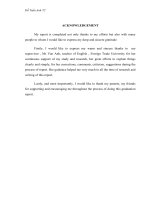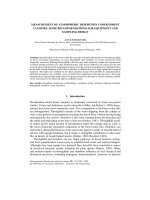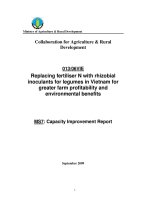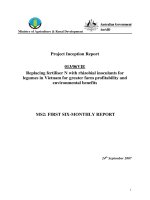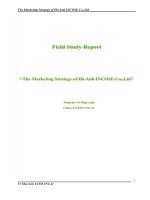Political marketing - contemporary review some recommendations for candidate in the run-up to national assembly election in Vietnam
Bạn đang xem bản rút gọn của tài liệu. Xem và tải ngay bản đầy đủ của tài liệu tại đây (1.05 MB, 110 trang )
vietnam national university, HANOI
school of business
Nguyen Tran Thi Anh
POLITICAL MARKETING-CONTEMPORARY
REVIEW
SOME RECOMMENDATIONS FOR candidate
in THE RUN-UP TO NATIONAL ASSEMBLY
ELECTION IN VIETNAM
master of business administration thesis
Hanoi - 2007
vietnam national university, HANOI
school of business
Nguyen Tran Thi Anh
POLITICAL MARKETING-CONTEMPORARY
REVIEW
SOME RECOMMENDATIONS FOR Candidate
in THE RUN-UP TO NATIONAL ASSEMBLY
ELECTION IN VIETNAM
Major: Business Administration
Code: 60 34 05
Master of business administration thesis
Supervisor:
1. Dr. NGUYEN VIET ANH
Hanoi – 2007
vi
TABLE OF CONTENT
Acknowledgements……………………………………………………………… i
Abstract……………………………………………………………………………ii
Tóm tắt……………………………………………………………………………iv
Table of contents………………………………………………………………….vii
List of tables……………………………………………………………………….x
List of abbreviations………………………………………………………………xi
INTRODUCTION ____________________________________________________ 1
1. NESCESSITY OF THE THESIS _________________________________ 1
2. RESEARCH OBJECTIVES _____________________________________ 2
3. RESEARCH METHODOLOGY _________________________________ 3
4. STRUCTURE OF THESIS ______________________________________ 3
CHAPTER 1: POLITICAL MARKETING LITERATURE REVIEW ____ 4
1.1 DEFINITION ________________________________________________ 4
1.1.1. Definition _______________________________________________ 4
1.1.2. Institutions in charge of elections ____________________________ 6
1.1.3. Mainstream marketing and political marketing __________________ 9
1.1.4. A new role for political markeitng: the permanent campaign ______ 11
1.2 POLITICAL MARKETING THEORY BY BRUCE l. NEWMAN _____ 12
1.2.1 Definition ______________________________________________ 12
1.2.2 The political marketing process _____________________________ 12
1.3 MARKETING STRATEGY BY DAVID M. REID _________________ 18
1.4 THE MARKETING PROCESS BY DONIMIC WRING ____________ 25
vii
1.5 POLITICAL MARKETING BY PHILIP KOTLER ____________________ 31
CHAPTER 2: NATIONAL ASSEMBLY ELECTION IN VIETNAM ____ 35
2.1 POLITICAL SYSTEM OF VIETNAM __________________________ 35
2.1.1 Overview of political system _______________________________ 35
2.1.1.1 The Communist Party of Vietnam __________________________ 35
2.1.1.2 The State Socialist of Republic of Vietnam __________________ 39
2.1.1.3 Socio-political and mass organization _______________________ 44
2.1.1.4 People in the political system _____________________________ 46
2.1.2 Vietnamese National Assembly _____________________________ 47
2.1.2.1 Introduction ___________________________________________ 47
2.1.2.2 Function of the National Assembly _________________________ 48
2.1.2.3 Duties and Compentence _________________________________ 52
2.1.2.4 Organization __________________________________________ 54
2.1.2.5 Session of the National Assembly __________________________ 57
2.1.2.6 Legal framework of the National Assembly __________________ 57
2.2 NATIONAL ASSEMBLY’ ELECTORAL PROCESS ______________ 59
2.2.1 The principle in election activities ___________________________ 59
2.2.2 Legal framework of the National Assembly election _____________ 60
2.2.3 The process of the National Assembly election ________________ 59
2.2.3.1 The process of the National Assembly election _______________ 60
2.2.3.2 Institutions in charge of the Election and their key roles ________ 61
2.2.3.3 Candidates selection process: Main steps ____________________ 62
2.2.3.4 Candidates selection process: Phases _______________________ 63
2.2.3.5 Electoral bodies ________________________________________ 64
2.2.3.6 Electoral units and polliing stations ________________________ 66
2.2.3.7 Electoral campaign _____________________________________ 67
viii
CHAPTER 3. RECOMMENDATIONS FOR CANDIDATES IN THE RUN-UP
TO THE UPCOMING NATIONAL ASSEMBLY ELECTION __________ 69
3.1 A GLANCE ON NATIONAL ASSEMBLY ELECTION IN VIETNAM 69
3.1.1. Anticipating voter needs __________________________________ 69
3.1.2. Marketing research in politics ______________________________ 71
3.1.3. The voter behavior _______________________________________ 75
3.1.4. Market segmentation and target group _______________________ 77
3.1.5. Candidate positioning ____________________________________ 77
3.1.6. Image management ______________________________________ 78
3.1.7. Marketing strategy _______________________________________ 78
3.2 FINDINGS AND RECOMMENDATIONS FOR CANDIDATES IN THE
RUN-UP TO THE UPCOMING NATIONAL ASSEMBLY ELECTION __ 79
3.2.1. Anticipating voter needs __________________________________ 79
3.2.2. Marketing research in politics ______________________________ 80
3.2.3. The voter behavior _______________________________________ 81
3.2.4. Market segmentation and target group _______________________ 83
3.2.5. Candidate positioning ____________________________________ 83
3.2.6. Marketing strategy _______________________________________ 84
CONCLUSION _____________________________________________________ 89
REFERENCES _____________________________________________________ 90
ix
LIST OF FIGURES
Figure 1: Stimuli Influencing Voter’s Perceptions 19
Figure 2: Formulating Political Marketing Strategy 21
Figure 3: The Political Marketing Process 27
Figure 4: Business and Political Marketing compared 32
Figure 5: Fours Markets faced by Candidates 33
Figure 6: A comprehensive Political Marketing Map 34
Figure 7: The organization of National Assembly of the Socialist Republic of
Vietnam 56
Figure 8: Process of National Assembly’ Election 60
Figure 9: Institutions in charge of the Elections and their key roles 61
Figure 10: Candidate’s selection process: Main steps 62
Figure 11: Candidate’s selection process: Phases 63
Figure 12: Electoral Bodies 64
Figure 13: Electoral units and polling stations 66
Figure 14: Electoral Campaign 67
x
LIST OF ABBREVIATIONS
CPV Communist Party of Vietnam
NA National Assembly
VFF Vietnam Fatherland Front
PCs People’s Council
UNDP United Nations Development Programme
1
INTRODUCTION
1. Nescessity of the thesis:
Since the reform process (called the Doi Moi) in Vietnam
commenced in 1986, reform initiatives have been introduced in all areas of
social life. In politics, some significant changes have occurred. The political
system has continued to open up both internally and in term of foreign
relations. In this respect, the establishment of the 1992 Constitution
represented a milestone by giving the National Assembly formal powers in
governing the country.
The National Assembly has strengthened its capacity to perform its
duties in recent years. The Assembly activities have become more open to
the public through its information channels. The focus on the importance of
parliamentary supervision has increased and the law making process is
guided by more intensive debates.
The international donor community has been invited to contribute in
parliamentary development. ―Strengthening Capacity of National Assembly
and People‘s Councils in state budget examination, decision and oversight
Project‖, ―Strengthening Capacity of People‘s Elected Bodies Project‖,
―Strengthening the Capacity of the Office of the Vietnam National Assembly
Project‖ have been implemented by supported of UNDP, Swiss Agency for
Development and Cooperation, the UK Department for International
Development and Canadian International Development Agency, The co-
operation is to enhance the democratic processes and to strengthen the
constitutional role and functions of the National Assembly.
2
In election, there also have some identified changing. Some electoral
campaign was launched, in someway, in the run-up to the May 2007
National Assembly. In electoral system, more interested group was
recognized officially in consultative conferences. And more self-nominated
was attempted.
Competition among candidates, especially in self-nominated group,
have been appeared and increased slowly. Candidates who want to win must
be prepared carefully both resources and long-term visions with clear and
smart strategies in election. A wide-range of information is published in
mass media, including internet, by government and other institutions. An
official election website www.baucuquochoi.gov.vn was launched in
supplementary information on election legislation and on the candidates.
These changing, both in political and electoral context, are significant
signal of applying in all aspects of political marketing in electoral activities.
2. Research objectives
The aims of this research are to systemize theories related to political
marketing and to build marketing strategy for politicians in Vietnam.
To reach the objectives, following questions need to be answered:
Question 1: What do other people talk about political marketing?
Question 2: What is the marketing strategy for politicians, in terms of?
Identify voter needs
Conduct market research
3
The voter behavior
Segment the market and identify target group
Determine positioning of candidate.
Manage the candidate image
And build marketing strategy
3. Research methodology
The researcher chooses a desktop study as main research method.
Observation was used to supplement the desktop study.
Collecting data were conducted over a six-month period during the
run-up to XII legislature. Most of information is comes from formal and
reliable sources. The principal source used for this research is the national
press and official website of government. The researcher scrutinized ten
national newspapers, with more than 400 articles, 80 websites of central
government, local government, socio-political and mass organizations. The
article covers the period from December, 2006 to July, 2007 (from when the
election date was announced to when the results were released). They
included a mixture of news reporting, editorials and the provision of
educational material.
Data analysis was completed in three stages. First, the articles
were transcribed into specific subjects. Second, data obtained were
categorized in accordance with each research questions. Third, the result was
evaluated and analyzed to design suitable marketing strategy for candidates.
4
4. Structure of thesis:
The content of thesis will be presented in following chapter:
Chapter 1: Political Marketing literature Review.
Chapter 2: National Assembly‘ Election in Vietnam
Chapter 3: Recommendations for candidate in the run-up to the National
Assembly Election.
5
Chapter 1:
Political Marketing Literature Review
1.1 Definition:
1.1.1. Definition:
Political Marketing as an academic discipline is relatively new, arising
as a result of the need by politicians to market themselves to their publics.
The rise of the political consultant has been attributed, in part, to the decline
of the political party bosses, the need for funding to be gained through large
numbers of voter contributions and the changing nature of communication
technology throughout the last few decades of this century.
For years, politicians have relied on basic marketing skills - campaign
buttons, posters, political rallies and campaign speeches to familiarize voters
with a name, a party, and a platform.
The same principles that operate in the commercial marketplace hold
true in the political marketplace: successful companies have a market
orientation and are constantly engaged in creating value for their customers.
In other words, marketers must anticipate their customers' needs, and then
constantly develop innovative products and services to keep their customers
satisfied. Politicians have a similar orientation and are constantly trying to
create value for their constituents by improving the quality of life, and
creating the most benefit at the smallest cost.
6
Political marketing, which is effectively the application of commercial
marketing to the political process has been defined in numerous ways by a
range of authors over the past two decades beginning from 1985.
In Maarek‘s view, political marketing has become an integral and vital
component of political communication. In his words: ―Political
communication…encompasses the entire marketing process, from
preliminary market study to testing and targeting‖. It should be noted that
Maarek admits that the main areas of application of political marketing are
image-making campaigns and election campaigns.
Lock and Harris point out that ―political marketing is concerned with
communicating with party members, media and prospective sources of
funding as well as the electorate‖. As they point of view ―the study of the
processes of exchanges between political entities and their environment and
among themselves with particular reference to the position of those entities
and their communications‖. And ―the practice of political marketing is
concerned with strategies for positioning and communications, and the
methods through which these strategies may be realized, including the search
for information into attitudes, awareness and response of the target audience.‖
Dominic Wring defines political marketing as ―the party or
candidate‘s use of opinion research and environmental analysis to produce
and promote a competitive offering which will help realize organizational
aims and satisfy groups of electors in exchange for their votes‖.
O‘ Cass argues that the use of marketing ―offers political parties the
ability to address diverse voter concerns and needs through marketing
analyses, planning, implementation and control of political and electoral
7
campaigns‖. Taking this one step forward he argues that ―the central purpose
of political marketing is to enable political parties and voters to make the
most appropriate and satisfactory decisions‖. O‘ Cass uses an exchange
model to define political marketing. According to him, when voters cast their
votes, a transaction takes place. In return for their votes, the party/candidate
offers better government and policies after election. This way, O‘ Cass
argues, marketing can be applied to political processes as it is specifically
interested in how these transactions are created, stimulated and valued.
Scammell notes that, due to the rapid expansion and the diversity of
this field of science, there is still no consensus on the definition of political
marketing. In her view, political marketing shares with history the desire to
explain political leaders‘ behavior, shares with political science the desire to
understand the political processes and shares with political communication
an interest in the art of persuasion.
Kotler defined ―Political marketing shares much in common with
marketing in the business world….In political campaigns, candidates dispatch
promises, favors, policy preferences, and personality to a set of voters in
exchange for their votes, voluntary efforts or contributions‖
Lees-Marshment point out that ―political marketing is about political
organizations adapting business marketing concepts and techniques to help
achieve their goals…to conduct market intelligence to identify the concerns
of those they serve change their behavior to meet those demands and
communicate their 'product offering' more effectively
1.1.2. Institutions in charge of elections
1.1.2.1 The politician's unique service obligations
8
The politician is in effect a service provider who must view the
voter/citizen as a consumer in the political marketplace. Similar to other
service providers, the politician is dealing in a competitive marketplace, and
as such needs to rely on similar approaches as do other service providers who
have unique service obligations in their respective marketplaces. However,
there are three situations that set the politician apart from other service
providers like doctors and lawyers
First of all, the politician is faced by situations that are both controllable
and uncontrollable. As opposed to other service providers like doctors or
lawyers, politicians must react constantly to forces within the environment
which are difficult to control. Politicians can, however, control the course of
events by establishing policies which are proactive rather than reactive.
A second dimension which sets politicians apart from other service
providers is the dual roles played by politicians as both a campaigner and
policy-maker. As a campaigner, the politician is in the business of trying to
win enough votes to get put into office. Careful scrutiny of his constituency
and competition is necessary to identify voter needs and capture competitive
niches in the marketplace. This often calls for the use of volunteers who are
hired on a temporary basis to carry out grass roots activities. As a policy-
maker, the politician relies on a permanent staff workers who help him carry
out his functions. The critical point to be made here is that the range of
activities and resultant strategies very much depend on the role which the
politician is playing.
The third distinction lies with the type and level of communication used by
the politician and his organization. Unlike other service providers, politicians
rarely can meet in person with all of their customers (or electorate), and
9
instead must rely on the use of mass media communications, public
appearances and direct mail procedures to make contact with their
constituencies. In many cases, the politician's organization is responsible for
making the contact. However, with respect to competition, politicians usually
have more face-to-face contact than we find in most other service industries.
1.1.2.2 The voter as a consumer
Marketers work very hard at shaping the expectations of their customers.
Expectations of customers are often influenced by the gaps in thinking that
exist between their own perceptions and those of the service provider.
One gap exists between the expectation of the consumer and
management's perceptions of those expectations. Particularly during
presidential primaries, candidates often change policies and promises to align
themselves with each state's electorate, even though their congressional
voting record suggests a different opinion altogether.
A second gap exists between quality specifications and service delivery.
In other words, there may be constraints which prohibit the candidate from
delivering what he/she perceives to be of vital importance to the voter.
Politicians are much more vulnerable to this gap than other service industries
as a result of the unexpected situations to which politicians must always
respond.
There also exists a gap between management perceptions and service
quality specifications. As opposed to other service industries, politicians do
not always have complete control over staffing, since civil servants are often
in positions not affected by changes in elected officials.
10
Finally, a fourth gap exists between the service delivery and external
communications. In other words, promises made in advertisements and
commercials which don't materialize in tangible results create problems for
the service provider. This is especially important for the politician who often
campaigns on a platform of promises which don't materialize into policy
when they get into office because of the bureaucracy in government or
puffery on the part of the candidate as a means of getting into office.
1.1.3. Mainstream marketing and political marketing
Philip Kotler:
Philip Kotler said that ―Certain differences between political marketing and
business marketing are alleged to exist in the public mind. They relate to
characteristics of the product, buyer and sellers.‖
1. Any specific commercial product is relatively fixed in its characteristics
at a given point in time. The political candidate, on the other hand, is more
variable. For one thing, the political candidate can talk back.
2. It is held that the political candidate cannot be as thoroughly formulated
for the market‘s needs as can physical products or services. But a given
political candidate cannot be varied freely in the same way. He has a history
and fairly set personality. It is not easy or even possible to remake a
humorless old candidate into a vigorous young one.
3. Business products are normally available for purchase any time at the
discretion of the buyer. Political products, however, are not ―put on sale‖
every few years.
11
4. The buyer of a commercial product or service usually expects personal
benefits enjoyed within a reasonable time period. Many citizen voters do not
expect to accrue any personal or early benefits from their act of voting
5. Buyer of commercial products and services are used to hard marketing
tactics whereas voters do not expect, and somewhat resent, hard marketing
tactics in the political area. A political candidate who would offer trading
stamps or who overdoes hard-sell advertising would be taking great risks.
6. The messages reaching the public about a commercial product are largely
marketer-controlled, through paid advertising. The media rarely feature or
comment on a brand of beans or toothpaste. On the other hand, the messages
reaching the public about a political candidate are largely developed by the
news media. As a result, the political candidate finds it necessary to market
himself as much to the press as to the ultimate public.
7. A business firm succeeds if it obtains any market share that yields a good
return on its investment; the political candidate succeeds only if he obtains a
plurality of the votes, that is, the largest market share.
8. The aims and means of the business seller and the political candidate are
different. The business seller is seeking profits. The political candidate is
seeking power. The business firm tries to secure more profits through creating
satisfied customers. The political candidate does not as clearly try to secure
more power by creating satisfied citizens
Lock and Harris
Lock and Harris identify seven main differences between mainstream and
political marketing:
12
1. Unlike every other purchasing decision, all voters make their choice on the
same day. Moreover, although there are similarities between opinion polls
and brand shares‘ tracking methods, the latter are based on actual purchasing
decisions while the former are based on hypothetical questions
2. Voting choice, unlike any other purchasing decision, has no direct or
indirect individual costs attached to it.
3. Voters have to live with the collective choice even though it may not have
been their preference
4. In elections winner takes all, especially in countries such as the UK where
the electoral system is ―first past the post‖.
5. Political parties and candidates are complex intangible products which the
voters cannot unbundled and thus they have to decide on the totality of the
package
6. In many countries it is very difficult to form a new and successful party
7. In most mainstreams marketing situations, brand leaders tend to stay in
front
Lock and Harris conclude that political marketing is at a ―craft‖ stage and
they find the assumption that there is direct transferability of mainstream
marketing theory to political marketing ―questionable‖. They claim that
political marketing has to develop its own frameworks by adapting the core
marketing literature and develop its own predictive and prescriptive models.
13
1.1.4. A new role for political marketing: the permanent campaign
Scammell argues that the blurring of boundaries between governing
and permanent campaigning could lead to the engineering of consent. She
also notes the worrying fact of political consultants‘ participation ―into the
inner sanctum of government‖. Still, she counter argues that the application of
the marketing concept in politics may result in politics becoming more
democratic. Political marketing can improve the quantity and quality of
information flows from the electorate to parties and candidates, thus making
them more sensitive and responsive to voters‘ needs. At the same time, it
improves the channels of communication from politicians to the electorate
and even more to every specific segment of voters. Thus, Scammell concludes
that ―‗political marketing‘ provides a rational way for parties or candidates to
behave in conditions of competitive mass democracy‖.
1.2. Political marketing theory byruce L.Newman:
Bruce I. Newman, PhD, is Professor of Marketing at DePaul University in
Chicago, and is one of the leading experts in the world on the subject of
political marketing. Dr. Newman combines an expertise in marketing and
politics with his knowledge of consumer psychology and statistical
applications. He has published seven books and numerous articles on the
subjects of political marketing and consumer psychology.
1.2.1 Definition:
Newman defined political marketing as,
14
…It has literally become impossible not to incorporate a marketing
orientation when running for office, or for that matter, when running
the country. Politics today is increasingly being influenced by
marketing, and the same advanced technological methods used by
corporate to market products are being used by politicians to market
themselves and their ideas. The modern day politicians must rely on
marketing not only to success the election, but to be successful as a
leader after winning.
1.2.2 The political marketing process:
1.2.2.1 Anticipating voter needs
Success in marketing goes beyond the simple identification of the
needs of consumers, but also includes the ability to forecast what those needs
will be in the future. Marketers must not only be able to measure and
identify the needs and wants of their customers', but they must also have a
vision which enables them to anticipate what those needs will be. Whether it
is a candidate, issue or product, marketing is a critical component to
understanding what voters, citizens or consumers want and need. Needs may
be driven by both emotion and rationality, resulting in people desiring the
same product or candidate for different reasons.
Marketing is a needs assessment approach to product innovation which
relies on information from the marketplace to help guide research and
development. This means that the most successful products are molded
around the findings from needs assessment studies. Just as a smart marketer
makes sure that there is a need for his product before he distributes it around
15
the country, so must a politician be sure that voters are concerned with an
issue before he decides to advocate it.
1.2.2.2. Marketing research in politics
The importance of doing research rests with the notion that not all
products can be sold to all consumers. Companies use marketing research to
determine what to stress to different consumer groups. Politicians are no
different. Marketing research and polling are of course not new to the field of
politics
There are many different types of polls that candidates rely upon,
including benchmark surveys (usually conducted after a candidate has
decided to seek office to provide a baseline of information); trial heat surveys
(used to group candidates together in hypothetical match-ups early in the
campaign); tracking polls (conducted on a daily basis near election day to
monitor any late shifts in support); cross-sectional and panel surveys
(conducted by the major polling firms over time to provide a picture of where
the electorate stands at different points during a campaign); and exit polls
(carried out immediately after the voter casts his or her ballot). In addition to
polling, candidates rely on focus groups, small numbers of people brought
together in a room to discuss either the candidates or their ideas. As the
group discussion goes on, campaign strategists sit behind a two-way mirror
and watch in an effort to get new insights into ways of altering their campaign
strategy.
One of the prerequisites to running a successful political campaign
these days is the incorporation of opposition research into the candidate's
campaign organization. The people who carry out this work are called in to
16
find out anything they can on a candidate's opponents. Unfortunately, these
people are often used to dig up dirt that eventually finds its way into a
political spot on television or radio, or in a lead to the press. This is not a new
activity. It is not unusual for a candidate to hire a firm to audit their own
personal past looking for any vulnerable spots they need to be protected.
Here the goal is to anticipate up front what a rival might say about you.
1.2.2.3. Market segmentation and targeting
In business, market segmentation and targeting are used to identify
those groups of customers who the marketer directs his product and
promotional campaign towards. It is used by many companies who choose
not to sell their product or service to every potential customer, but only those
who are likely to buy it. In politics, market segmentation has been
traditionally used by each of the political parties to choose which segments of
citizens they target with their appeals.
1.2.2.4. The voter behavior:
A predictive model of voter behavior proposes a number of cognitive
beliefs that may come from a wide range of sources, including the voter,
word-of-mouth communication, and the mass media. The model incorporates
the influence of individual‘s affiliation with groups of people in their social
environment and influence of party affiliation and past voting behavior. The
fundamental axiom of the model is that voters are consumers of a service
offered by a politician and, in that role, choose candidates based on the
perceived value they offer them. The model proposes that there are five
distinct and separate cognitive domains that drive voter‘s behavior.
1. Political issues represent the policies a candidate advocates and promises
17
to enact if elected to office. This component in the model captures some
classic literature in this field
2. Social imagery represents the use of stereotypes to appeal to voters by
making associations between the candidate and selected segments in
society. This component captures the influence of the role of party
affiliation and other important social networks that shape voter behavior.
3. Candidate personality captures the importance of a candidate‘s
personality in helping to reinforce and manufacture an image in the voter‘s
mind. Similar to the first two components in the theory, there is a
significant body of literature in the social sciences that supports this voter
domain.
4. Situational contingency represents that dimension of voters thinking that
could be affected by ―hypothetical events‖ that are profiled in the course
of a campaign. A candidate‘s opponents often use this tactic as a means of
creating the illusion that one candidate is better in dealing with certain
situations than the other candidate, in an effort to get voters to switch their
allegiance. There is literature in the field that supports this type of
research.
5. Epistemic value represents that dimension that appeals to a voter‘s sense
of curiosity or novelty in choosing a candidate. Very little research has
been conducted to document this dimension of voter behavior
1.2.2.5. Candidate Positioning
Once the multiple voter segments have been identified, the candidate
has to position himself in the marketplace. Positioning is multi-stage process
18
that begins with the candidate assessing both his own and his opponents'
strengths and weaknesses. Positioning is the vehicle which allows the
candidate to convey his image to voters in the best light possible. The image
is crafted through the media by emphasizing certain personality traits of the
candidate, as well as stressing various issues.
1.2.2.6. Image management
The image management process has also been used by political parties
to manufacture "new and improved" images that more accurately align them
with their changing constituencies. Along with this process has come a
constant shifting back and forth of people from one party to another and a
blurring of the definition of ideology in this country. In marketing terms,
ideology is a "labeling" process, almost similar in nature to the use of
branding for products. People have historically used ideology as a way of
labeling both themselves and politicians, and then making a connection
between themselves and the candidate and/or political party through the use
of this label. These labels are no different then the ones we see on products,
as well as attached to services offered by a whole host of professionals who
advertise in the hope of creating an image which defines who and what they
stand for in the minds of consumers. As a result of this change, ideology is
now driven less by party affiliation and more by marketing, and the latest poll
results indicting the mood of the electorate. Today, the labels liberal and
conservative in politics are no longer defined by the political parties, but by
the candidates themselves and the images their consultants craft for them.
Along with this change has come a dramatic shift in power from the political
party to the consultants.
1.2.2.7. Marketing Strategy
